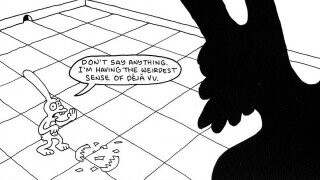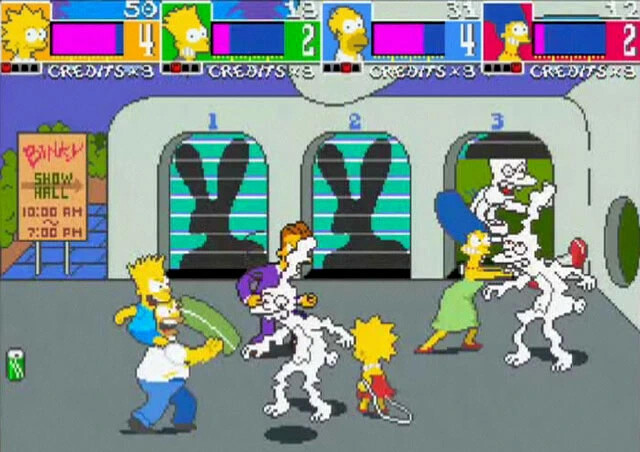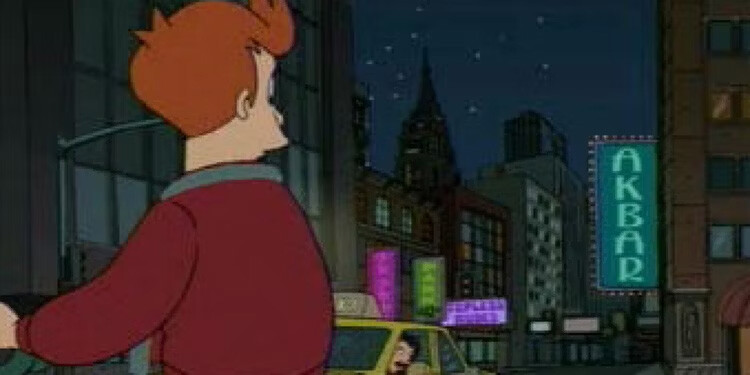15 Trivia Tidbits About Matt Groening’s ‘Life in Hell’

Long before Matt Groening would become synonymous with shows about a family with funny hair and space folk with funny anatomies, he was just a regular guy trying to make it in L.A. while drawing crude characters and turning them into zines. Life in Hell, however, proved popular enough to rocket its way from zine fame to comic-strip fame, enjoying 35 years of print success as Groening transitioned to mainstream television.
Featuring three anthropomorphic rabbits (Binky, Sheba and Bongo) as well as the iconic gay couple, Akbar and Jeff, the comic not only gave us an early glimpse of Groening’s propensity for all things angst (with a good dash of self-loathing to boot), but also informed much of what was to come from the gloomy creator.
Here are some trivia tidbits about the legendary comic strip that opened the door for the man who would change pop-culture history…
Akbar and Jeff Was Groening’s Failed Attempt at Drawing Charlie Brown

Matt Groening
“My friends and I were trying to draw Charlie Brown,” Groening has revealed. “We tried to imitate Peanuts, and they never came out looking right. And so, eventually, those drawings mutated into Akbar and Jeff. They still have the Charlie Brown shirt, if you noticed. Later I was trying to think about what kind of people they were and finally realized, of course, they’re gay, they’re lovers.”
Breaking News: Binky Once Had a Penis

Matt Groening
Talking to Playboy, Groening once confessed that he had a lot of questions about what he could get away with in his comic strip. “I went through a phase when I decided to systematically use every possible profanity,” Groening explained. “The strip kept getting kicked out of newspapers, so I stopped. At the very beginning, I had to decide whether or not to give the rabbits genitals. Bugs Bunny is neutered. All those characters are, really; there’s nothing down there. I tried drawing Binky with a penis for a while, but people were bothered by it. Akbar and Jeff appeared naked on the cover of The Village Voice with full frontal nudity.”
The Characters Showed Up in an Apple Computer Guide During the 1980s

Apple Computer
During the late 1980s, Groening worked as an artist for Apple, drawing up a guide for potential student Mac users that were humorous and featured his love for his rabbit characters.
Groening Started Drawing ‘Life in Hell’ While Working in a Record Store
After moving to Los Angeles to make all the money but, instead, ending up driving old directors around as their chauffeur, Groening took a job at a Licorice Pizza record store to make ends meet. During this period, he started drawing Binky and his comrades as a mirror of his Hollywood life in hell. In 1977, the cartoonist began sending his zines to friends back in Portland, and by the sixth issue, he had gone from 20 recipients to 500. Three years later, Life in Hell was running as a comic strip in the Los Angeles Reader and soon in many other publications.
‘The Simpsons’ Was Originally Going to Be a Show About the ‘Life in Hell’ Characters
Somewhere in the mid-1980s, famed executive producer James L. Brooks approached Groening to do a TV show based on Binky and the boys. Being smart, Groening didn’t want to lose ownership of his characters and suggested that he would rather start something from scratch. This is how The Simpsons came to be, and this also explains…
Why Marge Simpson’s Hair Is So Big
Groening initially created Marge as a character from his Life in Hell world and wanted her to reveal a pair of bunny ears hiding underneath that blue bouquet at the end of The Simpsons. Of course, all of that changed, but the big hair remained. However, the gag made it into The Simpsons Arcade Game, with Marge’s hidden bunny ears exposed whenever she gets electrocuted.

Konami
‘Childhood Is Hell’ is Based on Groening’s Fifth-Grade Diary

Matt Groening
“Most of us have forgotten what it was like to be in school,” Groening writes in Childhood Is Hell, adding, “I took notes.” In an interview, he explained that those notes made up a big chunk of his fifth-grade diary “because I got in trouble so much, and I wanted to have a record of that time to look at later to see whether I was right or not.” It was this diary that informed a lot of his strips in that particular collection.
The ‘Bunnyhop’ Controversy
Back in the 1990s, two San Francisco artists published a zine called Bunnyhop that featured musings on various pop-culture topics. Unfortunately, they released the zine with an image of Binky the Rabbit on one of their covers, thinking it would stand as a tribute to Groening. “I read Bunnyhop before they used my character on the cover, and I have a great deal of sympathy for the zine community and the First Amendment, and I’m a member of the ACLU and all that,” Groening told Mother Jones. “However, they used my character Binky on the cover, and it looked like I had done it. I hadn’t. It was Binky the Rabbit punching out the Trix cereal rabbit, so it implied I was violating the Trix rabbit copyright. There was no attribution, no indication it was satire, nothing in the magazine that explained anything. It just looked like something I had done. One of the things that happens in being successful is that stuff is out in my name that I didn’t do.”
A Beer Company Wanted Akbar and Jeff As Their Mascots (Before They Found Out the Two Were Gay)

Matt Groening
Groening revealed that a certain beer company (who he refrained from naming) approached him back in the day to potentially use the two characters as their new mascots. “They wanted Akbar and Jeff to be like Spuds MacKenzie and advertise their beer during spring break,” he recalled. “Then the article in Rolling Stone came out about me, and it was revealed that, ‘Oh my god. Akbar and Jeff — they’re not normal.’ And the beer company dropped Akbar and Jeff. I said, ‘Listen, these are cartoon characters. It’s not that big a deal. Spuds MacKenzie is a girl — he survived that scandal.’”
Groening’s Very First Published Story Informed Much of What We’d Later Get in ‘Life in Hell’
It turns out that Groening harbored those dark and often existentialist tones from a very young age. “My first national publication was in the third grade,” Groening told the Washington Post in 1988. “I won a short story contest in Jack and Jill magazine, a finish-this-story about a little kid on Halloween who went up into his attic, bumped his head and said, ‘Now I know what I want to be’ — and then you finished the story. Most kids wrote, ‘I wanna be a cowboy’ or ’a fireman.’ In mine, the kid struck his head, and he died, and they boarded up the attic, and every year on Halloween, he’d come down and eat dinner in silence with his family and then go back up to the attic.”
Yeah, that’s peak bleak.
Other ‘Life in Hell’ Characters Show Up in ‘The Simpsons Arcade Game’

Konami
Besides Marge Simpson’s hair gag, the 1991 beat-’em-up game also features Binky and Bongo lookalikes showing up in Krustyland and in the background of the game’s other levels.
The First Rendition of Binky the Rabbit Was Drawn in Grade School
Groening said that he and a couple of his friends started the Creature Club and made it their mission to draw all kinds of monsters. Groening revealed that after a failed attempt to draw a Batman character, he “started drawing little animals instead of trying to draw muscle guys.” Furthermore, “Rotten Rabbit was the villain, and that’s who Binky turned into. Binky was the only character people could recognize. I had an owl, and people thought it was a little bear.”
Groening’s Then-Girlfriend Helped Bring the Comic Strip to a Wider Audience
Groening’s girlfriend at the time, Deborah Caplan, was the one who started a small publishing company to distribute Groening’s first collection, Love Is Hell. From there, the series snowballed into a total of 15 books published to date.
The References in Groening’s Other Famous Work

Fox
Not only do both Maggie and Lisa play with Binky dolls in The Simpsons, but there’s a framed picture of Binky in the family’s TV room, while Akbar and Jeff also make cameo appearances. Naturally, the characters also show up in Futurama, with a giant AKBAR hotel sign in the background of the pilot episode and Binky and Bongo periodically popping by.
Groening’s Favorite Strips
Asked once by Rolling Stone which of his comic strips was his favorite, Groening mentioned the Love Is Hell collection but then admitted, “My very favorite strips over the years, however, were the self-indulgently parental ones in which I tape-recorded and then illustrated my kids’ arguments and stories. Now they say, ‘We’re not funny anymore, dad. And neither are you.’”

Matt Groening